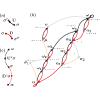当前位置:
X-MOL 学术
›
Phys. Rev. E
›
论文详情
Our official English website, www.x-mol.net, welcomes your
feedback! (Note: you will need to create a separate account there.)
State transition graph of the Preisach model and the role of return-point memory.
Physical Review E ( IF 2.2 ) Pub Date : 2020-07-09 , DOI: 10.1103/physreve.102.012122 M Mert Terzi 1 , Muhittin Mungan 2
Physical Review E ( IF 2.2 ) Pub Date : 2020-07-09 , DOI: 10.1103/physreve.102.012122 M Mert Terzi 1 , Muhittin Mungan 2
Affiliation

|
The Preisach model has been useful as a null model for understanding memory formation in periodically driven disordered systems. In amorphous solids, for example, the athermal response to shear is due to localized plastic events (soft spots). As shown recently by Mungan et al. [Phys. Rev. Lett. 123, 178002 (2019)], the plastic response to applied shear can be rigorously described in terms of a directed network whose transitions correspond to one or more soft spots changing states. The topology of this graph depends on the interactions between soft spots and when such interactions are negligible, the resulting description becomes that of the Preisach model. A first step in linking transition graph topology with the underlying soft-spot interactions is therefore to determine the structure of such graphs in the absence of interactions. Here we perform a detailed analysis of the transition graph of the Preisach model. We highlight the important role played by return-point memory in organizing the graph into a hierarchy of loops and subloops. Our analysis reveals that the topology of a large portion of this graph is actually not governed by the values of the switching fields that describe the hysteretic behavior of the individual elements but by a coarser parameter, a permutation which prescribes the sequence in which the individual hysteretic elements change their states as the main hysteresis loop is traversed. This in turn allows us to derive combinatorial properties, such as the number of major loops in the transition graph as well as the number of states constituting the main hysteresis loop and its nested subloops. We find that is equal to the number of increasing subsequences contained in the permutation .
中文翻译:

Preisach模型的状态转换图和返回点记忆的作用。
Preisach模型已被用作空模型,用于了解周期性驱动的无序系统中的内存形成。例如,在无定形固体中,对剪切的无热响应是由于局部塑性事件(软斑)引起的。正如Mungan等人最近所显示的。[物理 牧师 123,178002(2019)]中,可以根据定向网络严格描述塑性应变,该定向网络的过渡对应于一个或多个软点变化状态。该图的拓扑取决于软点之间的相互作用,并且当这种相互作用可忽略不计时,所得描述将成为Preisach模型的描述。因此,将过渡图拓扑与基本的软点交互联系起来的第一步是在不存在交互的情况下确定此类图的结构。在这里,我们对Preisach模型的过渡图进行详细分析。我们强调了返回点内存在将图形组织成循环和子循环层次结构中的重要作用。它规定了各个磁滞元件在遍历主磁滞回线时改变其状态的顺序。反过来,这又使我们能够导出组合属性,例如过渡图中的主要循环数以及状态数构成主磁滞回线及其嵌套子回路。我们发现 等于排列中包含的递增子序列数 。
更新日期:2020-07-09
中文翻译:

Preisach模型的状态转换图和返回点记忆的作用。
Preisach模型已被用作空模型,用于了解周期性驱动的无序系统中的内存形成。例如,在无定形固体中,对剪切的无热响应是由于局部塑性事件(软斑)引起的。正如Mungan等人最近所显示的。[物理 牧师 123,178002(2019)]中,可以根据定向网络严格描述塑性应变,该定向网络的过渡对应于一个或多个软点变化状态。该图的拓扑取决于软点之间的相互作用,并且当这种相互作用可忽略不计时,所得描述将成为Preisach模型的描述。因此,将过渡图拓扑与基本的软点交互联系起来的第一步是在不存在交互的情况下确定此类图的结构。在这里,我们对Preisach模型的过渡图进行详细分析。我们强调了返回点内存在将图形组织成循环和子循环层次结构中的重要作用。它规定了各个磁滞元件在遍历主磁滞回线时改变其状态的顺序。反过来,这又使我们能够导出组合属性,例如过渡图中的主要循环数以及状态数构成主磁滞回线及其嵌套子回路。我们发现 等于排列中包含的递增子序列数 。











































 京公网安备 11010802027423号
京公网安备 11010802027423号